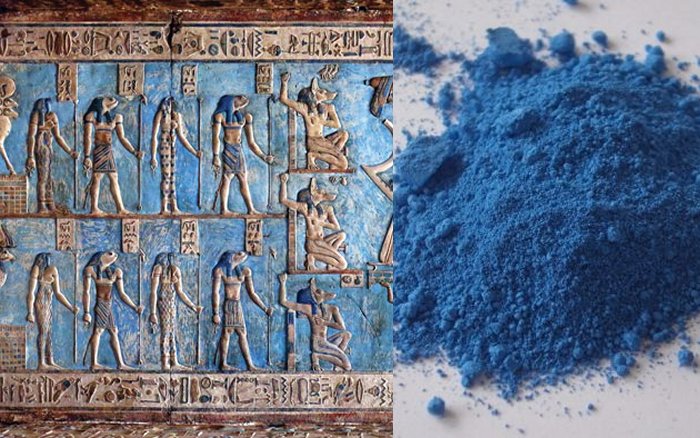Egyptian Blue: World’s Oldest Artificial Pigment
AncientPages.com - Question: What was the Egyptian blue?
Answer: The Egyptian blue is the world’s oldest artificial pigment. It appeared about 5,000 years ago in a tomb painting dated to the reign of Ka-sen, the last king of Egypt's First Dynasty.
Scientists have discovered that the Egyptian blue pigment has extraordinary properties and will enable us not only to reconstruct the past, but also possibly to shape the technological future.
The material giving Egyptian blue its color is calcium copper silicate. It was made by grinding sand, lime and copper (or copper ore) and heating the mixture in a furnace.
See also: Ancient Egyptians Had The First Governmental Health Care System
Egyptian blue was widely used in ancient times as a pigment in painting, such as in wall paintings, tombs, mummies’ coffins and a ceramic glaze known as Egyptian faience. The fact that it was not available naturally meant that its presence indicated a work that had considerable prestige. Its use spread throughout Egypt, Mesopotamia, Greece, and the far reaches of the Roman Empire. It was often used as a substitute for lapis lazuli, an extremely expensive and rare mineral sourced in Afghanistan.
Scientists have noticed that when irradiated with visible light, Egyptian blue emits near-infrared rays with exceptional strength, with even single particles of the pigment detectable from a distance of a few yards.
This suggests Egyptian blue could have a variety of modern applications. For example, it could soon be used in advanced biomedical engineering. Expanding on the ancient Egyptian concept with the pigment's near-infrared-emitting property, scientists can also use it as a nano-ink.
So, the Egyptian blue is certainly more than just a color.
AncientPages.com
Expand for referencesSource:
More From Ancient Pages
-
 The Mixtec – Mysterious Very Advanced Culture Of The Foremost Goldsmiths Of Mesoamerica
Civilizations | Dec 2, 2017
The Mixtec – Mysterious Very Advanced Culture Of The Foremost Goldsmiths Of Mesoamerica
Civilizations | Dec 2, 2017 -
 5 Traces Of Ancient Ancestors That Still Exist In All Human Bodies Today
Featured Stories | Jan 23, 2023
5 Traces Of Ancient Ancestors That Still Exist In All Human Bodies Today
Featured Stories | Jan 23, 2023 -
 Ancient Adobe Throne Found At Aslantepe, An Acient Hittite Site, Turkey
Civilizations | Aug 29, 2015
Ancient Adobe Throne Found At Aslantepe, An Acient Hittite Site, Turkey
Civilizations | Aug 29, 2015 -
 Underground Catacombs Of Alexandria: Ancient Time Capsule Which Remained Hidden For Almost Two Millennia
Featured Stories | Sep 20, 2016
Underground Catacombs Of Alexandria: Ancient Time Capsule Which Remained Hidden For Almost Two Millennia
Featured Stories | Sep 20, 2016 -
 Ancient Maya Ruins Of Tulum: Sea Port And Sacred Site For Worshiping Of Descending God
Featured Stories | Aug 10, 2016
Ancient Maya Ruins Of Tulum: Sea Port And Sacred Site For Worshiping Of Descending God
Featured Stories | Aug 10, 2016 -
 Hybrid Camels Revealed In Ancient Arab Temple Art At Hatra, Northern Iraq
Archaeology | Mar 15, 2022
Hybrid Camels Revealed In Ancient Arab Temple Art At Hatra, Northern Iraq
Archaeology | Mar 15, 2022 -
 Stolen Antique Tamil Nadu Statues Have Been Returned By Britain To India
Artifacts | Sep 23, 2020
Stolen Antique Tamil Nadu Statues Have Been Returned By Britain To India
Artifacts | Sep 23, 2020 -
 Who Was “Shimon”, Whose Name Appears On A 2,000-Year-old Hebrew Inscription?
Archaeology | May 20, 2023
Who Was “Shimon”, Whose Name Appears On A 2,000-Year-old Hebrew Inscription?
Archaeology | May 20, 2023 -
 Ancient Roman Port Discovered Off The Syrian Coast
News | Feb 16, 2021
Ancient Roman Port Discovered Off The Syrian Coast
News | Feb 16, 2021 -
 Rare Pre-Columbian Archaic Settlement Discovered In The Dominican Republic May Solve A Caribbean Mystery
Archaeology | Apr 12, 2022
Rare Pre-Columbian Archaic Settlement Discovered In The Dominican Republic May Solve A Caribbean Mystery
Archaeology | Apr 12, 2022 -
 ‘Collata Quipu’ May Explain Messages Hidden In Mysterious Writing Of Inca
Archaeology | May 10, 2017
‘Collata Quipu’ May Explain Messages Hidden In Mysterious Writing Of Inca
Archaeology | May 10, 2017 -
 Epona – One Of The Oldest And Widely Known Celtic Deities
Celtic Mythology | Feb 26, 2018
Epona – One Of The Oldest And Widely Known Celtic Deities
Celtic Mythology | Feb 26, 2018 -
 Ornamental Bronze Wall Plate Unearthed In Ayanis Castle Built By Urartian King Rusa II
Archaeology | Sep 13, 2022
Ornamental Bronze Wall Plate Unearthed In Ayanis Castle Built By Urartian King Rusa II
Archaeology | Sep 13, 2022 -
 How Many Ice Ages Has The Earth Had, And Could Humans Live Through One?
Featured Stories | Sep 26, 2022
How Many Ice Ages Has The Earth Had, And Could Humans Live Through One?
Featured Stories | Sep 26, 2022 -
 House Of Plantagenet – How Hatred, Revenge And Jealousy Transformed History
Featured Stories | Jul 27, 2018
House Of Plantagenet – How Hatred, Revenge And Jealousy Transformed History
Featured Stories | Jul 27, 2018 -
 Harput Relief: 4,000-Year-Old Artifact Pushes Back History Of Region By 1,000 Years
Archaeology | Mar 23, 2017
Harput Relief: 4,000-Year-Old Artifact Pushes Back History Of Region By 1,000 Years
Archaeology | Mar 23, 2017 -
 Babylonians And Sumerians Had Advanced Knowledge Of Astronomy
Civilizations | Feb 28, 2017
Babylonians And Sumerians Had Advanced Knowledge Of Astronomy
Civilizations | Feb 28, 2017 -
 Mysteries Of The Yellow Emperor – The ‘Son Of Heaven’ From Regulus
Chinese Mythology | Oct 10, 2021
Mysteries Of The Yellow Emperor – The ‘Son Of Heaven’ From Regulus
Chinese Mythology | Oct 10, 2021 -
 On This Day In History: Robert I, King Of Scots Known As ‘Robert The Bruce’ Was Born – On July 11, 1274
News | Jul 11, 2016
On This Day In History: Robert I, King Of Scots Known As ‘Robert The Bruce’ Was Born – On July 11, 1274
News | Jul 11, 2016 -
 Rare Unexpected Discovery Of Elizabethan-Era Ship At Quarry 300 Meters From The Coast
Archaeology | Jan 2, 2023
Rare Unexpected Discovery Of Elizabethan-Era Ship At Quarry 300 Meters From The Coast
Archaeology | Jan 2, 2023

